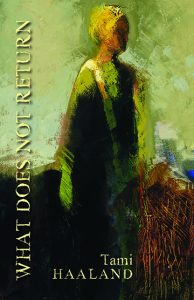
 Review by Barbara Ellen Sorensen
Review by Barbara Ellen Sorensen
In her new book, What Does Not Return, Tami Haaland’s poetry informs the reader that we are all intimately and inextricably tied to the natural world. The recognition of this interdependence is tightly woven throughout the book. Nature can impart many things and these poems ask us to pay attention to messages at once transcendent and temporal, visceral and ethereal.
Haaland leads us through an array of vistas including oceans, mountains, high deserts and prairies. In the first section titled “Forgetting,” these disparate landscapes come alive and serve as backdrops to a mother’s dementia: “The earth smells musty and rich.” (6) Haaland emerges as a fierce caregiver as she unravels the harrowing stages of her mother’s diminishing corporeal and cognitive states. Haaland writes, “It was a long while and it was yesterday./It was a year and a mile, a daily escape,/a treat, a burden, a weight.” (1), thus coming full circle as a child who must now become the parent to her parent.
With unflinching candor in the triolet, “A Little Prairie Song,” Haaland equates her mother’s dementia with a coiled snake: “Listen as her mind reels and tattles./Forgetting has swallowed it tail./And the snake coils and rattles” (3).
The effort of caregiving reaches a pinnacle when, in the book’s second section, in the poem “Noon Lockdown,” Haaland describes how she became a kind of surrogate mother to her students. During a lockdown drill for mass school shooters, a student “is angry because/her mother failed to text love,/so I kiss her head as I would kiss/the heads of my own grown children.” (28)
Further in the book, we are rocked from edenic prairies and mountains, meadowlarks and mourning doves and plunged into dark landscapes; there are hidden arsenals and B52s all around us. There are nuclear missiles, mosquitoes potentially carrying disease, and invasive Russian thistle that must be uprooted; this section embodies exactly its title: “World of the Eye’s Long Gaze.” (27)
Yet, in the midst of all of these menacing images there is the language of poetry and the solace of the natural world. Grief is part of our protean world and the poet welcomes its tributary of grace as she watches a whale plummet in and out of the water: “I thought, here I am again, failing to put to rest the past,/the thing shriveling in the interior, while this creature,/already a memory, overtakes what cannot be undone.” (64)
Haaland gifts us with the consolation of wild things— including roses, black currants, bees, rabbits, monarchs, pheasants, starlings—and we are propelled forward with the poet because, “We are bone/and bone, muscle and muscle,/and underneath each surface/a quiet and insistent pulse.” (58)
Likewise, there is solace in creativity; the poet notes that while engaging in paper folding, “Some kind of resonance emerged. Not jittery/but joyful.” (48) So too in sketching, “Our pencils uncover a star’s seven points…/Our pencils lead us, and we begin to see.” (44)
We realize that letting go is the last humane act we all must do and that in the midst of acceptance there remains doubt: “…it doesn’t matter where we live, what/continent or little town, we are/in the song, and those phrases/come back now. They remind me how I might/have held on longer before letting go.”(50)
What Does Not Return
by Tami Haaland
Lost Horse Press, 2018, [paper]
ISBN 978-0-9981963-6-7
65pp
Barbara Ellen Sorensen is the author of three books of poetry. She is a contributing writer to the Tribal College Journal and former senior editor of Winds of Change, the flagship magazine of the American Indian Science & Engineering Society (AISES).
